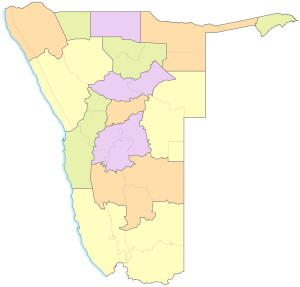Regions of Namibia
| Namibian Regions | |
|---|---|
 | |
| Category | Unitary state |
| Location | Republic of Namibia |
| Number | 14 |
| Populations | 102,762 (Omaheke) – 494,605 (Khomas) |
| Areas | 8,650 km2 (3,339 sq mi) (Oshana) – 161,510 km2 (62,361 sq mi) (ǁKaras Region) |
| Government |
|
| Subdivisions | |
 |
|---|
Namibia uses regions as its first-level subnational administrative divisions. Since 2013, it has 14 regions which in turn are subdivided into 121 constituencies.
Upon Namibian independence, the pre-existing subdivisions from the South African administration were taken over. Since then, demarcations and numbers of regions and constituencies of Namibia are tabled by delimitation commissions and accepted or declined by the National Assembly.
In 1992, the 1st Delimitation Commission, chaired by Judge President Johan Strydom, proposed that Namibia should be divided into 13 regions. The suggestion was approved in the lower house, The National Assembly. In 2014, the 4th Delimitation Commission amended the number of regions to fourteen.[1]
The most urbanised and economically active regions are the Khomas and Erongo region, with Khomas home to the capital, Windhoek, and Erongo home to Walvis Bay and Swakopmund.
The table below shows statistics from the 2023 Population and Housing Census:
| Region | Area (km²) | Population | People per km2 | Average Household Size |
|---|---|---|---|---|
| Erongo | 63,539 | 240,206 | 3.8 | 3.1 |
| Hardap | 109,781 | 106,680 | 1.0 | 3.6 |
| Kavango East | 23,988 | 218,421 | 9.1 | 5.3 |
| Kavango West | 24,591 | 123,266 | 5.0 | 5.5 |
| Khomas | 36,964 | 494,605 | 13.4 | 3.6 |
| Kunene | 115,260 | 120,762 | 1.0 | 3.8 |
| Ohangwena | 10,706 | 337,729 | 31.5 | 4.8 |
| Omaheke | 84,981 | 102,881 | 1.2 | 3.3 |
| Omusati | 26,551 | 316,671 | 11.9 | 4.2 |
| Oshana | 8,647 | 230,801 | 26.7 | 3.7 |
| Oshikoto | 38,685 | 257,302 | 6.7 | 4.1 |
| Otjozondjupa | 105,460 | 220,811 | 2.1 | 3.6 |
| Zambezi | 14,785 | 142,373 | 9.7 | 3.7 |
| ǁKaras | 161,514 | 109,893 | 0.7 | 3.1 |
Regions 1990–1992
[edit]
See also
[edit]References
[edit]- ^ Immanuel, Shinovene (12 April 2012). "Caprivi is no more". The Namibian.
- "Namibia 2001 Population and Housing Census". National Planning Commission. 2001. Archived from the original on 2012-01-11. Retrieved 2008-12-27.
